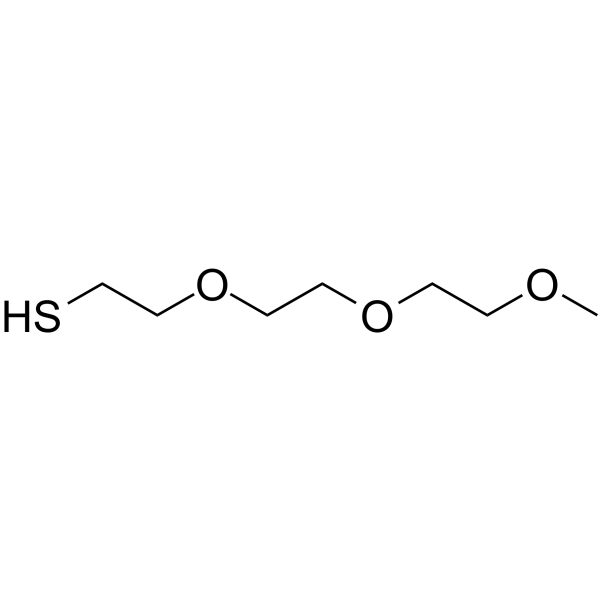
m-PEG3-SH
CAS No. 31521-83-2
m-PEG3-SH( M-PEG3-Thiol | 2-(2-(2-Methoxyethoxy)Ethoxy)Ethanethiol )
Catalog No. M26973 CAS No. 31521-83-2
m-PEG3-SH is a PEG-based PROTAC linker that can be used in the synthesis of PROTACs.
Purity : >98% (HPLC)
 COA
COA
 Datasheet
Datasheet
 HNMR
HNMR
 HPLC
HPLC
 MSDS
MSDS
 Handing Instructions
Handing Instructions
| Size | Price / USD | Stock | Quantity |
| 50MG | 38 | Get Quote |


|
| 100MG | Get Quote | Get Quote |


|
| 200MG | Get Quote | Get Quote |


|
| 500MG | Get Quote | Get Quote |


|
| 1G | Get Quote | Get Quote |


|
Biological Information
-
Product Namem-PEG3-SH
-
NoteResearch use only, not for human use.
-
Brief Descriptionm-PEG3-SH is a PEG-based PROTAC linker that can be used in the synthesis of PROTACs.
-
Descriptionm-PEG3-SH is a PEG-based PROTAC linker that can be used in the synthesis of PROTACs.(In Vitro):PROTACs contain two different ligands connected by a linker; one is a ligand for an E3 ubiquitin ligase and the other is for the target protein. PROTACs exploit the intracellular ubiquitin-proteasome system to selectively degrade target proteins.
-
In VitroPROTACs contain two different ligands connected by a linker; one is a ligand for an E3 ubiquitin ligase and the other is for the target protein. PROTACs exploit the intracellular ubiquitin-proteasome system to selectively degrade target proteins.
-
In Vivo——
-
SynonymsM-PEG3-Thiol | 2-(2-(2-Methoxyethoxy)Ethoxy)Ethanethiol
-
PathwayOthers
-
TargetOther Targets
-
RecptorApoptosis| Bcr-Abl| HDAC
-
Research Area——
-
Indication——
Chemical Information
-
CAS Number31521-83-2
-
Formula Weight180.26
-
Molecular FormulaC7H16O3S
-
Purity>98% (HPLC)
-
Solubility——
-
SMILESCOCCOCCOCCS
-
Chemical Name——
Shipping & Storage Information
-
Storage(-20℃)
-
ShippingWith Ice Pack
-
Stability≥ 2 years
Reference
1.Rabizadeh E, et al. Pivanex, a histone deacetylase inhibitor, induces changes in BCR-ABL expression and when combined with STI571, acts synergistically in a chronic myelocytic leukemia cell line. Leuk Res. 2007 Aug;31(8):1115-23. Epub 2007 Jan 30.
molnova catalog



related products
-
Sodium Molybdate
Sodium molybdate is a useful source of molybdate. In murine models Sodium molybdate dihydrate inactivated both the active and inactive form of the glucocorticoid receptor complex.
-
EZH2-IN-15
EZH2-IN-15 (SHR2554) is a specific inhibitor of the zeste 2 histone modification enhancer (EZH2).EZH2 is aberrantly overexpressed in many human cancers and controls adaptive responses by regulating Treg activity.
-
Ac-VEID-pNA
Ac-VEID-pNA is an artificially synthesized peptide. Ac-VEID-pNA is utilized as substrate for caspase 6, that cleaves the lamin A at the cleavage site of VEID.



 Cart
Cart
 sales@molnova.com
sales@molnova.com


